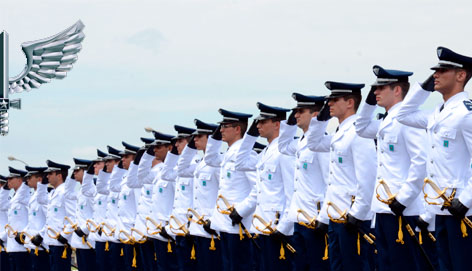Situational Leadership:
a study of applicability of the Hersey and Blanchard model in the CCAer leadership chain
DOI:
https://doi.org/10.22480/revunifa.2024.37.538Keywords:
Situational Leadership. Military Leadership. Maturity. Leadership Styles.Abstract
This article is based on a research within the leadership chain - CLC of the Aeronautical Cadet Corps-CCAER. Among all the situational leadership theories researched, the Hersey and Blanchard model was chosen, as this study has a methodology aligned with the existing reality in the process of training Air Force Cadets from the 1st to the 4th squadrons. Investigate the possibility of adopting an ideal leadership style for each squadron, establishing a specific style according to the respective degree of maturity of each squadron. The necessary information for studying the application of situational leadership was collected through two questionnaires. The study used bibliographic research and surveys for data collection. Each CCAER Squad sees itself with a moderate-high “M3” maturity level, with disparities between the idealized style and the one adopted by the leaders. It was also evidenced that there is no increasing graduation in the maturity of the groups, and the troop can increase, maintain or decrease the level of organizational maturity. All this information was enough to reach conclusions that situational leadership is applicable as long as the organizational culture is considered and that there are gaps between idealized styles x employees, contributing to a discrepancy of expectations between leader and subordinate, generating frustrations that make it difficult to this one in the Chain of Leadership.
References
BRASIL. Ministério da Defesa, Academia da Força Aérea. Manual do Cadete da Aeronáutica. Pirassununga, 2020.
BRASIL. Ministério da Defesa, Academia da Força Aérea. Programa de Treinamento de Liderança do CCAER. Pirassununga, 2009b.
BRASIL. Ministério da Defesa, Academia da Força Aérea. Programa de Treinamento Militar do CCAER. Pirassununga, 2009a.
BRASIL. Ministério da Defesa, Comando da Aeronáutica. MCA 2-1. Manual de Liderança da FAB. Brasília, DF: 2016b.
BLAKE, R e MOUTON, J. S. O Grid Gerencial. 3. ed. São Paulo: Pioneira, 1978.
CHIAVENATO, Idalberto, Introdução a Teoria Geral da Administração, 7ª edição, Elsevier, Rio de Janeiro - RJ, 2003.
FIEDLER, F. (1965): Engineer the Job to fit the manager; Harvard Business Review; September-October; pp. 115-122 apud CHIAVENATO, Idalberto. Introdução à Teoria Geral da Administração: uma visão abrangente da moderna administração das organizações, 7ª ed. Rio de Janeiro: Elsevier, 2003.
GOLEMAN, Daniel. O poder da inteligência emocional: como liderar com sensibilidade e eficiência. 1ª ed. – Rio de Janeiro: Objetiva, 2018. Título original: Primal Leadership: Unleash.
HERSEY, Paul; BLANCHARD, Kenneth. Psicologia para administradores: a teoria e as técnicas da liderança situacional. São Paulo: EPU, 1986.
HOUSE, J. R.; DESSLER, G. The Path-goal Theory of leadership: Some Post Hoc and A Priori Tests, 1974 apud ROBBINS, Stephen - Comportamento organizacional - 11. ed. - São Paulo: Pearson Prentice Hall, 2005.
LIKERT, Rensis. Novos padrões de Administração.São Paulo, Pioneira, 1971.
MONTANA, Patrick; CHARNOV, Bruce. Administração. São Paulo: Saraiva, 1998.
Robbins, Stephen R, Comportamento Organizacional - 11. ed. - São Paulo: Pearson Prentice Hall, 2005.
SILVA, Marcos Antonio da. Aplicação da liderança situacional na enfermagem de centro cirúrgico. 2004. 87 f. Dissertação (Mestrado) - Programa de Pós-Graduação em Enfermagem Fundamental do Departamento da Enfermagem Geral e Especializada, Escola de Enfermagem de Ribeirão Preto, Universidade de São Paulo, Ribeirão Preto, 2004.
SCHEIN, Edgar. Cultura Organizacional e Liderança. São Paulo: Atlas, 2009.
VIEIRA, Belchior. Liderança Militar. Academia Militar – Estado-Maior do Exército, 2002.

Downloads
Published
Issue
Section
License
Copyright (c) 2024 Luiz Fernando Nascimento dos Reis, Maria Estela Ferreira do Nascimento

This work is licensed under a Creative Commons Attribution-NonCommercial 4.0 International License.
Revista da UNIFA permite que o (s) autor (es) mantenha(m) seus direitos autorais sem restrições. Atribuição-NãoComercial 4.0 Internacional (CC BY-NC 4.0) - Revista da UNIFA é regida pela licença CC-BY-NC








